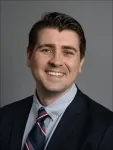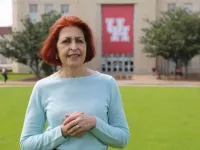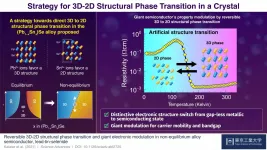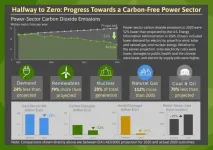(Press-News.org) When the Webster-Kirkwood Times, a community newspaper in the greater St. Louis, Missouri area, had to endure layoffs and stop publishing its print edition -- due to a loss in revenue as a result of the COVID-19 pandemic -- its readers felt the loss and began supporting the newspaper in earnest.
"A lot of times people don't know what they've got until it's gone," said Jaime Mowers, editor-in-chief of the Webster-Kirkwood Times. "Now, there is such a newfound appreciation for the newspaper. It's amazing to have the community's support, knowing we are loved that much and appreciated enough to be able to bring our print edition back. We are part of the fabric of our community, and we're lucky to still be a part of that."
Community newspapers, like the Webster-Kirkwood Times and those in rural America, often serve as the public's main source of accurate, local news. They also can be an important way to share the impact of major national events, such as a global pandemic. As the COVID-19 pandemic began spreading throughout the United States, journalism scholars at the University of Missouri and the University of Kansas found that community newspapers across the country began to reevaluate the way they had been doing business for decades.
In their new study, the journalism scholars analyzed six weeks of news articles and columns in community newspapers that described COVID-19's impact on the journalism profession. They found journalists in these local newsrooms were now open to the idea that "everything is on the table" for their survival. As part of that philosophy, journalists are beginning to embrace the need for self-advocating for their profession in a way that prior generations were historically uncomfortable doing, said Ryan J. Thomas, associate professor of journalism studies in the Missouri School of Journalism.
"There has been a tendency within journalism to avoid journalism itself becoming the story, and let the quality of the work speak for itself," Thomas said. "Journalists have been holding onto this view that if they put out a quality product, the public will appreciate them. But what we've found, and which is also consistent with a few other similar studies, is that journalists' internal view of their own profession is changing. Journalists are now recognizing the need to be their own advocates, not only for the importance of their role in a democracy, but also for their own survival -- by trying to encourage people to subscribe, renew their subscription and so on."
Within two months of the COVID-19 pandemic reaching the U.S., at least 30 local newspapers across the country closed or merged due to financial situations. Meanwhile, hundreds of other community newspapers responded with layoffs, furloughs and production changes, such as shifting to an exclusive online format and reducing the number of print editions. Thomas said this shift in thinking also recognizes that reliance on an advertising model, the source of revenue for much traditional journalism, is a risky venture. He said their research revealed a debate between editors and publishers about whether or not paywalls -- a newer form of revenue for many media organizations -- should be used to access news about the coronavirus.
"On one hand, journalism is a public service and information about the coronavirus is essential for making the community aware of the health threats and safety measures that should be taken," Thomas said. "On the other hand, if that information is located behind a paywall, people cannot access it. However, a paywall is also one source of revenue and can help keep the lights on. That's what makes this a complicated situation."
Teri Finneman, an associate professor in the School of Journalism and Mass Communications at the University of Kansas, and co-author on the study, was glad to see how honest journalists were when writing about their situations.
"Over the last decade or so, I think the public keeps hearing the soundbite that journalism is dying, but I don't know if the public truly understands how journalism works," said Finneman, who received her master's degree and doctorate from MU. "So, it's important that journalists have more of these honest conversations with the public, so that the public has a greater understanding of what journalists need to be able to adequately serve them. Journalism does have business model challenges, and while some areas in journalism are thriving and great work is being done, journalism still needs communities to invest into their local newsrooms similar to the effort that journalists are making who are invested in serving the needs of their local communities."
INFORMATION:
The study, "Our Company is in Survival Mode": Metajournalistic Discourse on COVID-19's Impact on U.S. Community Newspapers," was published in the journal Journalism Practice.
BUFFALO, N.Y. - Mindfulness is big business. Downloads of mindfulness apps generate billions of dollars annually in the U.S., and their popularity continues to rise. In addition to what individual practitioners might have on their phones, schools and prisons along with 1 in 5 employers currently offer some form of mindfulness training.
Mindfulness and meditation are associated with reducing stress and anxiety, while increasing emotional well-being. Plenty of scholarship supports these benefits. But how does mindfulness affect the range of human behaviors -- so-called prosocial behaviors -- that can potentially help or benefit other people? What happens when the research looks outwardly at social effects of mindfulness rather than inwardly at its personal effects?
It's ...
Human screams signal more than fear and are more acoustically diverse than previously thought, according to a study published April 13th 2021 in the open-access journal PLOS Biology by Sascha Fru?hholz of the University of Zurich, and colleagues. Remarkably, non-alarming screams are perceived and processed by the brain more efficiently than alarming screams.
In nonhuman primates and other mammalian species, scream-like calls are frequently used as an alarm signal exclusively in negative contexts, such social conflicts or the presence of predators or other environmental threats. Humans are also assumed to use screams to signal danger and to scare predators. But humans scream not only when they are ...
First study to examine suicides occurring around the world during the COVID-19 pandemic finds that - in high-income and upper-middle-income countries - suicide numbers have remained largely unchanged or have declined in the early months of the pandemic, compared with expected levels.
However, the authors stress that governments must remain vigilant as the longer-term mental health and economic effects of the pandemic unfold and be poised to respond if the situation changes.
Study looked at numbers of suicides in 21 countries between 1 April and 31 July 2020 and compared these with trends in the previous one to four years.
A new observational study ...
Screaming can save lives. Non-human primates and other mammalian species frequently use scream-like calls when embroiled in social conflicts or to signal the presence of predators and other threats. While humans also scream to signal danger or communicate aggression, they scream when experiencing strong emotions such as despair or joy as well. However, past studies on this topic have largely focused on alarming fear screams.
Humans respond to positive screams more quickly and with higher sensitivity
In a new study, a team at the University of Zurich Department of Psychology led by Sascha Frühholz ...
Living near a hazardous waste or Superfund site could cut your life short by about a year, reports Hanadi S. Rifai, John and Rebecca Moores Professor of Civil and Environmental Engineering at the University of Houston. The study, published in Nature Communications and based on evaluation of 65,226 census tracts from the 2018 Census, is the first nationwide review of all hazardous waste sites and not just the 1,300 sites on the national priority list managed by the federal government.
The analysis shows a decrease of more than two months in life expectancy for those living near a Superfund site. When coupled with high disadvantage of sociodemographic factors like age, sex, marital status and income, the decrease could be nearly 15 months, ...
A group of researchers led by Brazilians has used an innovative model to map gaps in the Amazon rainforest and identify factors that contribute to tree mortality. Water stress, soil fertility, and anthropic forest degradation have the most influence on gap dynamics in the world's largest and most biodiverse tropical rainforest, according to an article on the study published in Scientific Reports.
Forest gaps are most frequent in the areas with the highest levels of soil fertility, possibly because the abundance of organic material drives faster tree growth and shorter life cycles.
The main method of data collection ...
The electronic properties of solid materials are highly dependent on crystal structures and their dimensionalities (i.e., whether the crystals have predominantly 2D or 3D structures). As Professor Takayoshi Katase of Tokyo Institute of Technology notes, this fact has an important corollary: "If the crystal structure dimensionality can be switched reversibly in the same material, a drastic property change may be controllable." This insight led Prof. Katase and his research team at Tokyo Institute of Technology, in partnership with collaborators at Osaka University and National Institute for Materials Science, to embark on research into the possibility of switching the crystal structure dimensionality of a lead-tin-selenide alloy semiconductor. Their results appear in a paper published ...
A study carried out by the University of Granada indicates that smoking cannabis significantly alters key visual functions, such as visual acuity, contrast sensitivity, three-dimensional vision (stereopsis), the ability to focus, and glare sensitivity
Yet, more than 90% of users believe that using cannabis has no effect on their vision, or only a slight effect
A group of researchers from the Department of Optics of the University of Granada (UGR) has studied the effects of smoking cannabis on various visual parameters compared to the effect that the users themselves perceive the drug to have on their vision.
This study, led by Carolina Ortiz Herrera and Rosario González Anera, has been published in the journal Scientific Reports. Its main author, Sonia Ortiz Peregrina, explains that ...
Concerns about climate change are driving a growing number of states, utilities, and corporations to set the goal of zeroing out power-sector carbon emissions. To date 17 states plus Washington, D.C. and Puerto Rico have adopted laws or executive orders to achieve 100% carbon-free electricity in the next couple of decades. Additionally, 46 U.S. utilities have pledged to go carbon free no later than 2050. Altogether, these goals cover about half of the U.S. population and economy.
These are ambitious targets, but a new look at the past 15 years in the electricity sector shows that large reductions in emissions are possible.
New research from the Department of Energy's Lawrence ...
As the Rhode Island legislature considers designating the Northern Star Coral an official state emblem, researchers are finding that studying this local creature's recovery from a laboratory-induced stressor could help better understand how to protect endangered tropical corals.
A new study published today in mSystems, a journal of the American Society for Microbiology, investigates antibiotic-induced disturbance of the coral (Astrangia poculata) and shows that antibiotic exposure significantly altered the composition of the coral's mucus bacterial microbiome, but that all the treated corals recovered ...






